
May 20 2022 Sephardic Holiday Customs
When my daughter Shira was in fourth grade at a Jewish day school, her teacher taught all the Passover songs and customs, from Mah Nishtanah to pinkie-dipping ten drops of wine during the recitation of the Ten Plagues. One day, she came home upset.
“Nothing we learned was what we do at home,” she said. “It’s as if our customs don’t exist.”
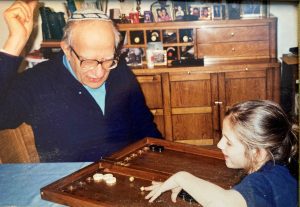
Our family is from India. We trace our roots to 17th-century Baghdad and Syria. My father was the great keeper and purveyor of our traditions to his children and grandchildren. He passed away from Covid almost two years ago, but his spirit and teachings imbue every special custom we continue to follow.
Most American Jews are Ashkenazic, originally from Eastern European countries including Russia, Poland, and Austria. Sephardic and Mizrahi Jews originally from Spain, Portugal, the Middle East, and Asia celebrate the same holidays and some of same customs, and we also have different ways of celebrating being Jewish, including melodies and traditions like henna ceremonies before a wedding that reflect local culture.
Many Sephardic holiday customs are perfect for grandparents to share with their grandchildren, no matter what their ages. They are often hands-on and interactive and fun to do together.
The following traditions are just a taste of the rich abundance of Sephardic life. Try them to spice up your own family table!
![]() Click HERE to learn more about Sephardic customs and foods.
Click HERE to learn more about Sephardic customs and foods.
Shavuot
Shavuot celebrates the event in the Torah when Moses and the Israelites received the Ten Commandments at Mt Sinai, seven weeks after leaving Egypt. It is a custom in both Ashkenazic and Sephardic communities to participate in all-night (or late into the evening) study on Shavuot.
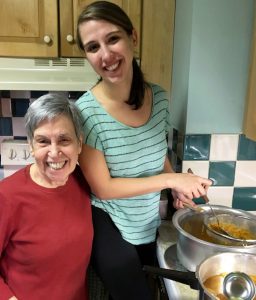
In our home in Calcutta, the study featured a mind-boggling survey of the Torah, a kind of an ancient religious version of speed-dating: We read aloud the beginning and end of each of the 54 parashiot (portions) of the Torah and the beginning and end of the remaining 19 books of the Tanakh (Bible)!
We didn’t study all night on an empty stomach, of course. A fluffy layered Baghdadi bread called Kahi, similar to Indian paratha, was eaten with sweet halwa (different from sesame-based halva, made from fine semolina, fried in sugar and butter and fluffed up with a swirl of water.
How can we adapt this Torah study custom? You can choose a short section of the Torah — perhaps the story of Noah for younger children, your grandchild’s upcoming B-Mitzvah portion, or the story of the giving of the Torah (Exodus 19–20) for any age. Read the first few lines together and create a one- or two-line summary. Perhaps act it out. You might make a video and share it with family members. You could even set your story to a song you love and sing it together. Have your grandchild decide how best to bring your story to life! You can make a pizza or cookies together instead of the kahi.
If you live at a distance from your grandchild, you can Zoom, Facetime, or WhatsApp your Torah study, and even cook together virtually.
Rosh Hashanah
A seder for Rosh Hashanah? Yes! This home ritual is a fabulous celebration featuring food and fun that is easy to incorporate into your new year observance.
On Rosh Hashanah, it is traditional to dip apples in honey in hopes of a sweet new year. Jews around the world share other foods as well: pomegranates, pumpkins, beans, beets, and dates. The custom has its roots in Talmudic times. The foods were chosen for their ability to grow abundantly and so symbolize prosperity. Each is associated with a wish for the year ahead crafted from one of its attributes, or a wordplay on its name (“May we date this new year with an end to enmity”; “May the year be as filled with mitzvot as the pomegranate is filled with seeds”).
You can use the foods, songs, and folktales as presented in my book, Apples and Pomegranates: A Family Seder for Rosh Hashanah. Or create your own Rosh Hashanah seder, choosing foods with your grandchildren and coming up with funny wishes (“In the year ahead I will always show you how much OLIVE you!”).
![]() Click HERE to read more about Sephardic Rosh Hashanah seders.
Click HERE to read more about Sephardic Rosh Hashanah seders.
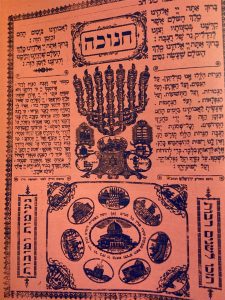 Hanukkah
Hanukkah
Many Sephardic and Mizrahi families traditionally celebrate Hanukkah without much fanfare: no latkes, dreidels, jelly donuts, gelt, or rainbow-colored candles (we use oil and wicks). One treasured custom in my family was hanging up a vibrantly printed “Hanukkah paper” by the hanukkiah. Each paper was imprinted with the holiday blessings, psalms, and symbols, personalized for each child with their name hand-written at the bottom.
You can prepare your own Hanukkah papers with your grandchild. Each of you can include three symbols: of yourself, of your family, and of Hanukkah. For example, if you love sports, music, or art, you could add a baseball, a flute, or an artist’s palette. If your family enjoys spending Shabbat together or going to the beach, you could add a drawing of candlesticks or the ocean. You can each add your own personal prayer for this Hanukkah. If your grandchild is a toddler, they can decorate with finger paints.
![]() Click HERE to read more about Sephardic Hanukkah traditions.
Click HERE to read more about Sephardic Hanukkah traditions.
Passover
 Sephardic families love to role-play to fulfill the directive in the Haggadah: “You should show yourself as if you yourself had left Egypt.” (The Sephardic Hebrew text reads “show yourself” instead of the Ashkenazic version, “see yourself.”) After the middle matzah is broken, many Sephardic Jews place the afikomen in a large scarf and knot the ends together to create a makeshift knapsack. The youngest child places the knapsack over their shoulder as if leaving Egypt.
Sephardic families love to role-play to fulfill the directive in the Haggadah: “You should show yourself as if you yourself had left Egypt.” (The Sephardic Hebrew text reads “show yourself” instead of the Ashkenazic version, “see yourself.”) After the middle matzah is broken, many Sephardic Jews place the afikomen in a large scarf and knot the ends together to create a makeshift knapsack. The youngest child places the knapsack over their shoulder as if leaving Egypt.
You can then ask three easy questions:
- Q: From where have you come?
A: From Egypt. - Q: Where are you going?
A: To Jerusalem. - Q: What are your provisions for the way?
A: The child simply points to the knapsack with matzah.
This is also an opportunity to have the child decide how the scene should play out and to create the dialogue.
Everyone then sings Mah Nishtanah together.
 Food is so often the centerpiece of memory. Because we had a cook in India, my mother learned her way around the kitchen only when we came to the United States. She was already 32 years old. She transmitted her recipe for love — food — to her children and grandchildren.
Food is so often the centerpiece of memory. Because we had a cook in India, my mother learned her way around the kitchen only when we came to the United States. She was already 32 years old. She transmitted her recipe for love — food — to her children and grandchildren.
One of our favorite Passover foods is haroset, which symbolizes the mortar the Israelites used to make bricks in Egypt. Our haroset, called halek, is made from dates that are boiled and strained until they are the consistency of thick honey, and later sprinkled with chopped walnuts. You can assemble a sampler of the different Sephardic recipes for haroset, from our Baghdadi version to a spiced mixture with over a dozen kinds of fruits and nuts, including dates, pomegranates, bananas, oranges, and pistachios that you can shape into bricks (Persian).
![]() Click HERE to read about more Sephardic Passover customs.
Click HERE to read about more Sephardic Passover customs.
When we share these diverse traditions with our grandchildren, they enrich our holiday experiences with an additional layer of meaning. My children are now 35 and 29. They will never forget what their grandparents taught them.
![]() Click HERE to learn more about the history of Sephardic Jews.
Click HERE to learn more about the history of Sephardic Jews.
Rahel Musleah is a journalist, educator, and the author of several books on Jewish holidays. She leads Jewish heritage tours to India, where she was born. Visit www.explorejewishindia.com to read the author’s blog about Jewish life in India.
Photographic Credits
Banner photograph courtesy of Unsplash
Photographs by Rahel Musleah

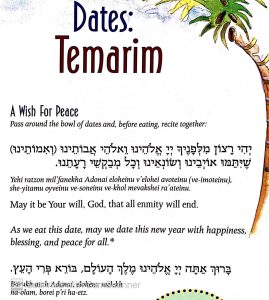
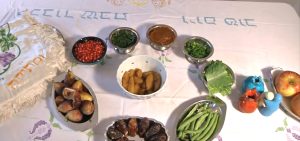


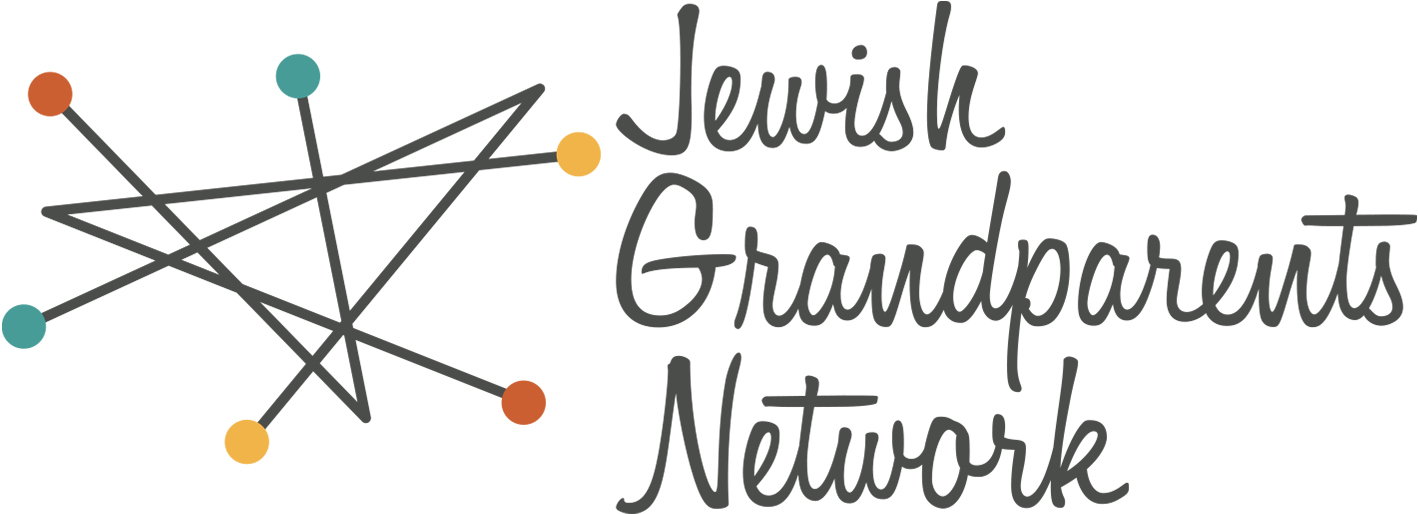
 We use technologies like cookies to remember your preferences. Consenting to these technologies will provide you with a better browsing experience. JGN never shares information about your use of our website.
We use technologies like cookies to remember your preferences. Consenting to these technologies will provide you with a better browsing experience. JGN never shares information about your use of our website.